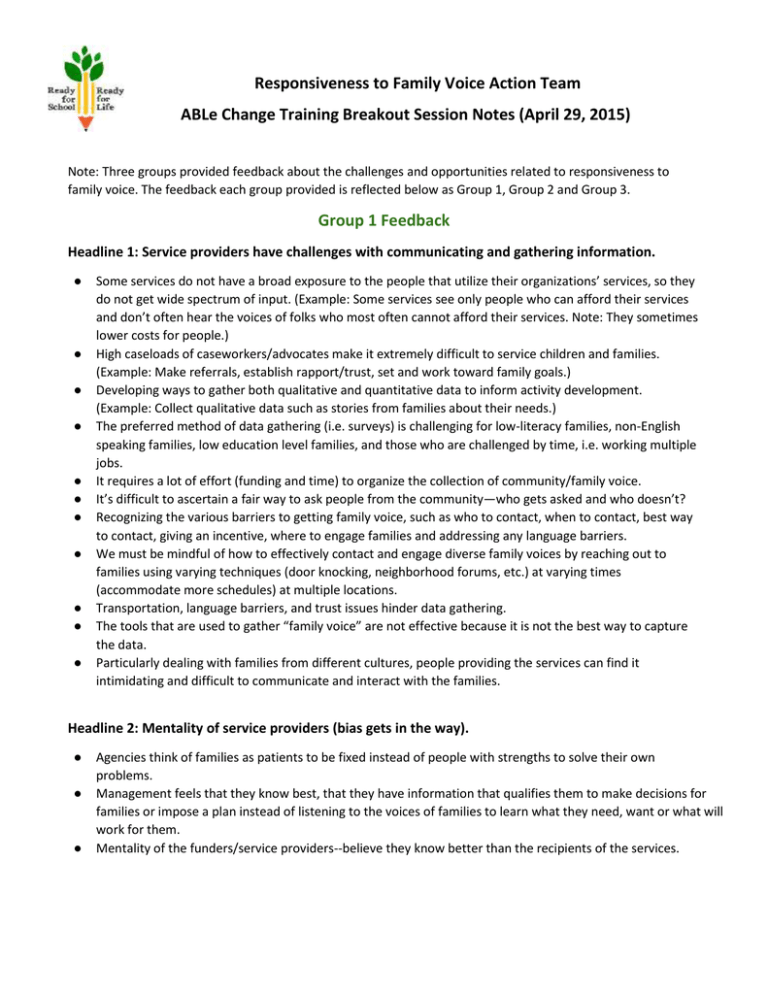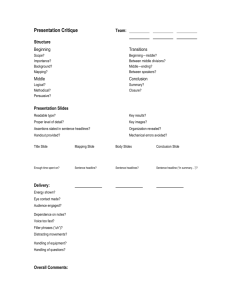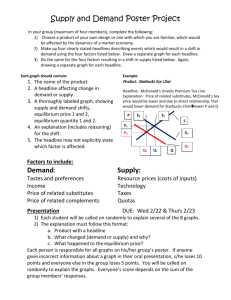Here's what participants said about responsiveness to family voice.
advertisement

Responsiveness to Family Voice Action Team ABLe Change Training Breakout Session Notes (April 29, 2015) Note: Three groups provided feedback about the challenges and opportunities related to responsiveness to family voice. The feedback each group provided is reflected below as Group 1, Group 2 and Group 3. Group 1 Feedback Headline 1: Service providers have challenges with communicating and gathering information. ● ● ● ● ● ● ● ● ● ● ● Some services do not have a broad exposure to the people that utilize their organizations’ services, so they do not get wide spectrum of input. (Example: Some services see only people who can afford their services and don’t often hear the voices of folks who most often cannot afford their services. Note: They sometimes lower costs for people.) High caseloads of caseworkers/advocates make it extremely difficult to service children and families. (Example: Make referrals, establish rapport/trust, set and work toward family goals.) Developing ways to gather both qualitative and quantitative data to inform activity development. (Example: Collect qualitative data such as stories from families about their needs.) The preferred method of data gathering (i.e. surveys) is challenging for low-literacy families, non-English speaking families, low education level families, and those who are challenged by time, i.e. working multiple jobs. It requires a lot of effort (funding and time) to organize the collection of community/family voice. It’s difficult to ascertain a fair way to ask people from the community—who gets asked and who doesn’t? Recognizing the various barriers to getting family voice, such as who to contact, when to contact, best way to contact, giving an incentive, where to engage families and addressing any language barriers. We must be mindful of how to effectively contact and engage diverse family voices by reaching out to families using varying techniques (door knocking, neighborhood forums, etc.) at varying times (accommodate more schedules) at multiple locations. Transportation, language barriers, and trust issues hinder data gathering. The tools that are used to gather “family voice” are not effective because it is not the best way to capture the data. Particularly dealing with families from different cultures, people providing the services can find it intimidating and difficult to communicate and interact with the families. Headline 2: Mentality of service providers (bias gets in the way). ● ● ● Agencies think of families as patients to be fixed instead of people with strengths to solve their own problems. Management feels that they know best, that they have information that qualifies them to make decisions for families or impose a plan instead of listening to the voices of families to learn what they need, want or what will work for them. Mentality of the funders/service providers--believe they know better than the recipients of the services. Headline 3: Families have significant challenges providing information. ● ● ● ● ● ● ● Families do not participate due to lack of support from agencies/systems who are asking for information. Families must be actively involved/included in the process of getting children ready for school. Having ways to find the families that need services (i.e. they may be isolated due to factors such as location, culture or desire to stay under the radar) Families have so many other things (such as unemployment or lack of transportation) that take priority. Sometimes gathering the information is too overwhelming for the families because they may not understand what’s being asked. Parents of abused children experience guilt, shame or fear and are reluctant to open up. Families bring a perspective about poverty, homelessness, disabilities, and being a refugee that need to be heard in preparing and getting children ready for school. Headline 4: Need to bridge the gap between funders and families. ● ● Have funders require family voice as part of the proposal process. Often it is not a requirement and services do not adequately meet their needs. Need to overcome past history of families being left out of developing services. May need to do some relationship building to build trust. Group 2 Feedback Headline 1: Language and culture barriers prevent family voices from being heard. ● ● ● ● Some services are only provided at times and locations that conflict with parents’ schedules. Language barriers and educational experience result in difficulties for refugees/immigrants who don’t know how to navigate the system. The language barrier and cultural difference sometimes create misunderstandings about the services available, why they are beneficial and expectations of parent involvement. Systems don’t have the resources to accommodate clients who speak languages other than English. Headline 2: Pre-existing regulations cause a lack of flexibility of services. ● ● Programs already exist with outcomes already outlined. Head Start programs are the result of federal/state directives with little or no room for change. Headline 3: Resource restrictions get in the way of seeking family input. ● ● Asking for parent input is extremely time consuming and we have too little time. There’s not enough time to build trusting relationships and get to the core of parent needs and concerns Asking for parent input is an overwhelming task for service providers. It requires a multi-tiered approach: Internet, in person, in several languages, etc. Headline 4: Families feel powerless because there’s a history of their input being ignored. ● ● When Head Start families are included in “focus groups”, their ideas and contributions are not acted upon. Families may not feel like they have a voice due to feeling unimportant and not empowered to share their opinions, ideas, experiences and values. Headline 5: Leaders and service providers don’t take family input into account when creating services/programs. ● ● ● ● Head Start services are already identified, but often not needed. There’s no room for expressed needs for families. In existing system, programs are created top-down and without family input. Our attitude (as service providers) is often that “we know what’s best for families.” Decision makers many not gather/use family voice because they are unwilling or reluctant to give up power and control. They may be resistant to change. Group 3 Feedback Headline 1: Cultural barriers prohibit families from coming to the table ● ● ● ● ● ● Lack of cultural sensitivity (not aware of different cultural behaviors). Cultural barriers such as language issues get in the way. Difficulties getting families to the table due to scheduling, childcare, single family homes, transportation, and language barriers. Lack of interpreters/translators. No training and don’t know what to ask families. When families move to this area without the language or ability to ask questions they need, then they need interpreters to make the process smoother. Need to be equipped to deal with language barriers so we can provide the right services to families. Headline 2: Agencies lack the ability to understand the family voice and change their own behaviors. ● ● ● ● ● ● ● ● Nobody is taking responsibility to do the work in asking parents; responsibility is passed on. (Nobody to follow up even when they ask. No efforts. Yes worry about numbers, but not real family concerns.) Agencies make quick decisions to get funding, interfering with getting collective feedback from families. Be aware of our own biases (stereotyping based on our own opinions) Mindset that the agency doesn’t believe the families have a voice because there are disconnects where families and agencies are concerned. Often, those making the decisions do not want to come out of their comfort zones to meet with families needing the services. Decision makers are more comfortable working from their offices instead of going out to the communities. Families are not included because their opinion may be different from program creators’ thinking. Often program creators already know what they want to do and do not want to have to start over to implement family voice. Providers assume that parents do not know what’s needed, so they all do the same thing or provide the same services every year. They (providers) look at it as a paying job and they do not believe they can make a change. Decision makers must move beyond the requirements of “the job” and be passionate about being genuine as opposed to a courtesy. Headline 3: Agencies need to develop deep relationships with each other and the community they serve. ● ● ● Training--Advocates don’t know what to ask families, they don’t know families’ issues or concerns, base everything on standard questions. We need to build better relationships with families in order to establish trust and to help bridge the gap in the system of change. We need to physically go into communities to ask families of various ethnic backgrounds what their specific needs are. Headline 4: Lack of resources/funding for agencies interferes with the ability to gather diverse input from families. ● ● ● ● ● ● ● Agencies don’t have the resources to do any more, so asking families what they need is pointless. Agencies don’t know where to find the families that might be available and — when we do (find them) — what we do, we even ask them? (Why do they need it?) We need to stop asking generalized questions to families and work to create more specific questions targeting the problem. We need to revisit the process of collecting data as it pertains to creating ways to serve our families. Programs are already in place and there is not an emphasis placed on family input. Decision makers are afraid to hear the truth — families may want more than a program can give. These demands may be necessary for the upkeep of what a program is offering. There’s sometimes a level of intimidation on both sides. Agencies feel vulnerable because they could lose parts of their programs.
![[Type text] Fill in a fictional “headline from the future” above](http://s3.studylib.net/store/data/008674091_1-c12eeba0d4bd6938777e08ea064ad30a-300x300.png)







